A Few Paddles:
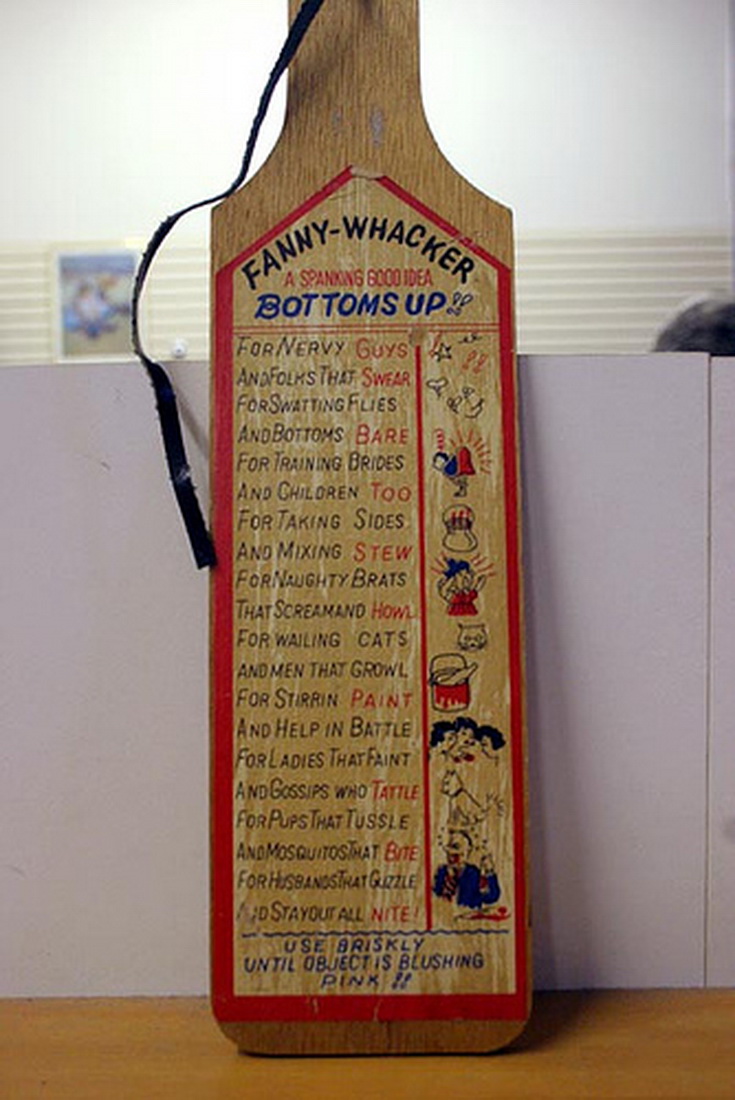
Paddle for the Funny Man

Paddle for the Frat Man
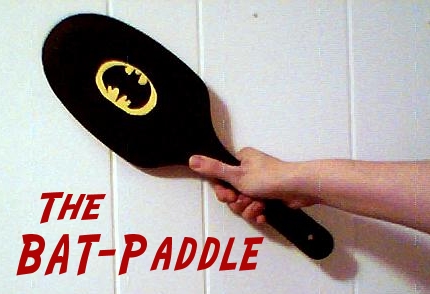
Paddle for the Batman (courtesy of Arkham Insanity, whose own bottom has felt its sting from time to time)
Chicago Spanking Review |
Everything You Always Wanted To Know About Paddles**but were afraid to find out by getting swats with one! |
---> Articles Section |
By Web-Ed |
|
This article discusses my favorite spanking implement - the paddle - and is intended to complement my article on how to use this and other common implements. I will give some brief history, and then go into the various types available and make some comparisons. Of course, no one type of paddle can be best for everyone; much depends on the specific use (i.e., type of paddling, as there are several) to which it will be put, and, of course, on individual preferences, which can be based on either physical or psychological factors. I wrote this article mainly from recollected facts without doing any significant additional research, and when I had finished I found more than 5,000 words had been core-dumped from my brain onto this page – frightening to think that there was so much paddling information just rattling around in the ol’ skull! While intended as a serious work, I felt a certain amount of humor was appropriate and necessary given the subject matter – the application of a paddle to the buttocks! It should make you smile just thinking about it. As an example, and for the benefit of those who have not yet reached middle-age, I will mention that the title above is an obvious play on Dr. David Ruben’s bestseller “Everything You Always Wanted To Know About Sex* (*but were afraid to ask)” -- The Web-Ed (December 2008, revised November 2012) |
|
A Brief History of Paddles and Paddling The century in which the paddle first appeared is not known (at least not to me). I have found some early references to paddle-type implements made of wood in France and Germany which apparently were used occasionally for discipline (in England, of course, the Birch and Cane predominated, while Asia had rods, canes, and whips). It was in America that the paddle as we think of it today blossomed into its modern forms, yet it seems to have a rather unfortunate history: early photographs reveal that wooden ones were sometimes used on slaves, apparently in the belief they were less damaging to the skin than the whip. An ugly beginning, with a sorry lineage continuing to this day in the form of schools that use corporal punishment - a modern-day example of the infliction of suffering upon the helpless. There is, however, a second line of descent from this ignoble beginning leading to something more salutary - adult erotic and disciplinary spanking! This second line seems to have proceeded from the use of the paddle in domestic discipline (DD). The early colonists and settlers in this country must have quickly become good carpenters out of necessity, and with an abundant supply of New World timber, we should not be surprised that a few wooden paddles were fashioned along with log cabins and various items of furniture. And while DD itself obviously has contributed greatly to adult spanking, it also branched out into yet another offshoot, the "fun spanking". As far as I can tell, this happened because of college fraternities (sororities presumably came later), though not at first through hazing rituals, as one might have expected. It seems that the seniors (and perhaps even a few masters) apparently felt some moral obligation to act in loco parentis (in place of the parent) for the benefit of the younger boys who were away from the protection and discipline of home for the first time. (Remember that before the 1920’s, teenagers had very little freedom and independence, especially compared to today.) This practice then gradually evolved into the "fun" paddling, first as part of hazing and later as an independent kind of entertainment. To avoid any confusion, let me state clearly that in my opinion, hazing as such was and is an abominable practice, because it became over time less an expression of juvenile but harmless tomfoolery than an outlet for (and even encouragement of) a vile sort of cruelty (how and why this happened is an entirely different subject). The significant fact for our purposes here is that the paddlings were supposed to be fun, just like the non-hazing paddlings which seem to have largely supplanted them. Actually, I have no hard figures on this, but the threat of civil liability has prodded many colleges and national organizations to reign in the excesses of individual fraternity chapters, so that hazing is not what it used to be (we may hope), and paddling is often prohibited entirely, at least officially. Unofficially, or off-campus, or with locals not subject to National jurisdiction, the paddling continues. Judging by the photos and videos found on the net, the college kids involved seem to be to having a good time, with the exception of some of those on the receiving end, and probably most of the excessively hard or careless swats that are given are caused as much by youthful ignorance as actual malice. All the booze probably doesn't help much either. Other examples of "for fun" spankings abound. There are some (probably not many) non-college fraternal organizations that still paddle their initiates, a practice obviously derived from their collegiate counterparts; girlfriends sometimes playfully spank each other (and not just in spanking videos, either); traditional birthday spankings are still around, and spankings continue to be found in bars and taverns (for some examples, see our Gallery and Video sections). I find it remarkable (and revealing psychologically) that waiters and waitresses are actually giving their customers swats with a paddle! Now the two significant facts I have been trying to establish here (at some length) are that (1) spanking is seen as a fun activity in some contexts, and (2) a paddle is most often used in these situations - certainly no one would think of using a cane or a tawse! |
|
Why Use A Paddle? As we all know, the classic spanking is given with the hand, which is always, well, at hand. The main problem with the hand is that is isn’t designed to take all the abuse of spanking someone. Proper technique certainly helps, but sooner or later many of us find we’re absorbing as much punishment as the Sub! Using an implement solves this problem, and because of the greater lever arm the speed of the swat is increased, meaning that a paddle can deliver more sting than the bare hand. Of course, there are other implements besides the paddle, such as the cane and the strap. The primary difference between the paddle and other implements is that unlike them, it has a fixed, rigid shape, which allows for the greatest overall control. Let’s summarize some of the paddle’s characteristics and compare them with other implements:
Balancing Sting vs. Thud Everyone understands what is meant by “sting”, but “thud” is a more elusive concept. If you’re a Top, ask your Sub what she experiences other than sting when she gets a swat to give you some idea what this means (if you’re a Sub, then you already know!). While much of this question will boil down to personal preferences, there are some things you should know to help you select the paddle that gives you the best balance between sting and thud. After many years of experience, it is my opinion that we should try to give the Sub a fair amount of sting with relatively little thud. The reason for this is that I believe sting is largely a surface phenomenon, perceived on or just below the skin, whereas thud originates in the deeper tissues. The last thing we want to do is cause extensive bruising or other kinds of tissue damage; on the other hand, we do want to ensure we deliver a good sting! So, how do we control sting vs. thud? To understand this, we must get a little scientific for a moment, but I promise that the serious calculations have been relegated to the appendix for those few readers that may find them of interest. Through careful study and consideration, I believe that the amount of sting experienced by the Sub is related to the amount of kinetic energy (KE) dissipated near the surface the paddle is applied to, while the amount of thud is related to the total momentum possessed by the paddle. I will not give the precise definitions of KE and momentum here (see appendix or any textbook on physics), but I think everyone will agree that “more energy = more sting” is at least a plausible idea. My theory is that the amount of momentum determines how much pressure is actually applied to the buttocks; more momentum means more pressure and greater displacement, hence more “thud” and greater likelihood of bruising. The appropriate calculation (see appendix) shows that we can increase KE relative to momentum (more sting for a given amount of thud) by using lighter paddles at greater speed. Conversely, heavier paddles applied at lower speed would result in relatively more thud. Put in simple, practical terms, to give more sting without bruising, we should use lighter paddles - those made of less dense and/or thinner materials. Some specific recommendations will be given in the section on materials. |
|
A Few Paddles: |
|||

Paddle for the Funny Man |

Paddle for the Frat Man |
||

|
Paddle for the Batman (courtesy of Arkham Insanity, whose own bottom has felt its sting from time to time) | ||
|
Shapes and Materials All kinds of shapes have been used, but the best and most common are basically either rectangular or oval, each of varying sizes, materials, and thicknesses. I explain the problems with round and heart-shaped paddles in a separate article, Paddling Mistakes. The common materials used for fashioning a paddle are listed below:
|
|
Shapes and Materials |
|||
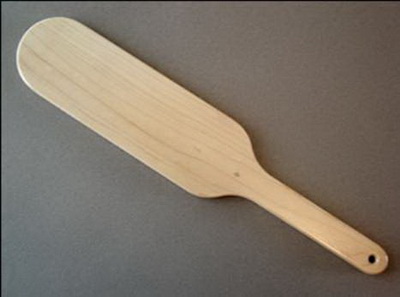
|
Illustration 1.1 - Wood 18" long by 3-1/2" wide by 3/8" thick, solid maple. If I were only allowed to own one wooden paddle, it would have dimensions very close to these. Birch, ash, oak, and exotic woods may be substituted. Note that both the end and the edges have been rounded - an important design feature to prevent any cutting effect. From Hanson Paddle Werks. |
||
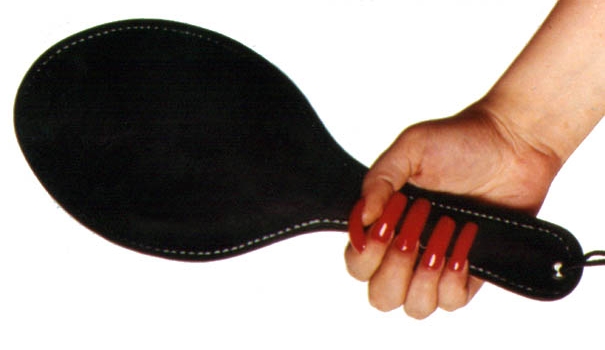
|
Illustration 1.2 - Leather Oval-shaped leather paddle. Possibly the single best style of any paddle ever made, combining good coverage and sting with little chance of bruising. There is a “stiffener” running through the center to prevent excessive flexing where the handle joins the body. |
||
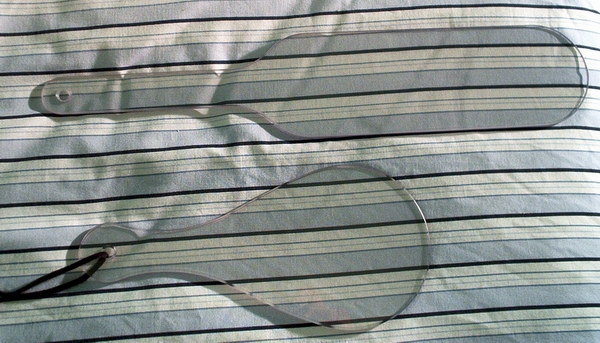
|
Illustration 1.3 - Lexan Unbreakable lexan in 1/4" thickness. Imparts a burning sting. Hanson Paddle Werks. |
||
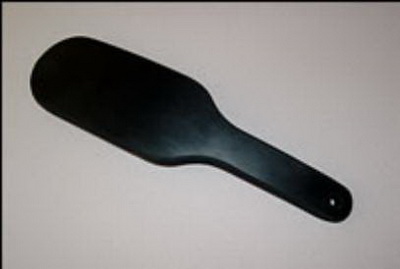
|
Illustration 1.4 - Rubber Rubber paddle. Not nice. From Hanson Paddle Werks. |
||
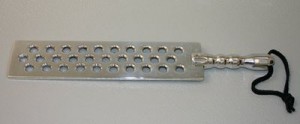
|
Illustration 1.5 - Aluminum Aluminum paddle, lovely to look at but too dense for practical spanking purposes. I don't know where this one was made, but I found the picture at A.S.S. |
||
|
Additional Types and Features of Wooden Paddles: |
|||
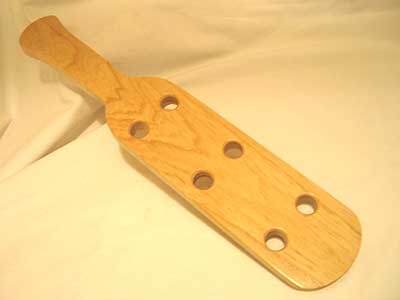
Illustration 2.1 |
Holes (see Illustration 2.1) – there’s a lot of misinformation about holes floating around out there. The story is always told in every school where this kind of paddle is used that the purpose of the holes is to lower air resistance, thus increasing the speed of the swat. But although I admit I haven’t calculated the force of air friction on a paddle with and without holes, I find the “reduced air resistance” theory highly dubious since (1) inertia (mass) is probably a greater factor in holding down paddle speed than air resistance; (2) any lessening of air resistance is accompanied by a decrease in momentum (because of the loss of mass), which is not necessarily bad, but you could accomplish the same thing more easily by using a lighter paddle (see “Balancing Sting vs. Thud” above, or the appendix); (3) even ½” paddles without holes can be applied with as much speed as anyone could reasonably want – just ask someone who’s felt one; and (4) William Cooper, in his book Flagellation and The Flagellants, claimed that the holes are intended to act as miniature cups. |
||
|
And in fact the only effect I have ever observed is the raising of round welts, which I think is just plain nasty and not at all in keeping with the ideals of either good fun or loving discipline. I've also heard these referred to as Spencer Paddles, and I once saw a photo of what I believe to be the original Spencer Paddle that did indeed have alternating rows of different-sized holes, but historically holes predated the Spencer Spanking Plan (1936) by decades (again, I've seen the photos). By the way, small holes (less than dime-sized) seem to make no difference at all - it's the nickel-and-larger sizes to watch out for. If you can be satisfied with the idea of holes, then consider drilling small ones, perhaps painting black disks around them which will make them appear larger while doing no actual damage. Holes are not recommended, but if you really want to try them, at least make sure they're beveled to make them easier on the skin (See Illustration 2.5). What we've said here about holes in wood paddles also applies to Lexan. |
|||

Illustration 2.2 |
|||
|
Triangle Paddle (see Illustration 2.2) - my name for a paddle with holes in a triangular-shaped pattern that one of my high school teachers showed me back in the 70's. He didn't use it on us - it was a relic from his own schooldays many years earlier where it was applied to boys in swimming class. Now in those days, when there were no girls around, boys used to swim naked, so they would have gotten this thing on the bare bottom! The idea must have been to leave a triangle stamped on the boy where everyone could see it, although the holes were so small, maybe 1/8", that I can't imagine it actually worked. The chief effect of this innovation in paddle technology was probably to increase the mystique of paddling, thus helping to warp at least two generations of boys (if you count me as a generation). Why it never occurred to anyone that people who would devise such a thing needed watching, or that paddling naked boys during swimming class might have an effect on their future development, is hard to say - just how dumb are school administrators, anyway? What kind of effects, you ask? Well, there was a certain girl who gave me a lot of grief shortly after this time, and I used to dream of making her touch her toes, carefully aligning the paddle, and giving her a swat that would emboss that triangle shape right where it would do her the most good! Years later, but when I was still young, I actually did drill a triangle-shaped pattern of holes into a paddle, and they made absolutely no difference at all! Ah well, the silly fancies of youth (and before you ask, no, I don't still have one of these things). The interesting part was that the idea of "wearing a triangle" had considerable appeal to a very special lady (not the troublesome one) I was spanking at the time. |
|||

Illustration 2.3 - novelty paddles. Bend over, brats, and feel some heat for the seat! |
Novelty Paddles (see Illustration 2.3) - for many years a staple of gift shops everywhere. Intended more for bucolic humor than serious discipline, they often have silly sayings or even entire verses painted on. I suppose when I was a kid my favorite ones were the "All-Purpose Fanny Paddle" and "Heat For The Seat" (see Illustration 2.3), which for some strange reason I thought was really exciting, what with its red lettering and all. Believe it or not, I've actually used them, but they're not generally as well-made as their more serious counterparts, having defects such as non-rounded edges and uncomfortable grips. I have no idea how many are sold in a year, but for boys too young to be warped by Triangle or Finger paddles in high school, they can be warped by seeing these things while they're still in grade school! Of course, it may be that I'm exaggerating, and that being surrounded by paddles and paddling will do no harm at all to impressionable young people. After all, during my boyhood and adolescence it seems I somehow managed to run into every single make, model, and style of paddle ever manufactured in the Western Hemisphere - and look how well I turned out. |
||

(click to enlarge and read all the reasons why this fanny paddle should be "put to work") |
|||
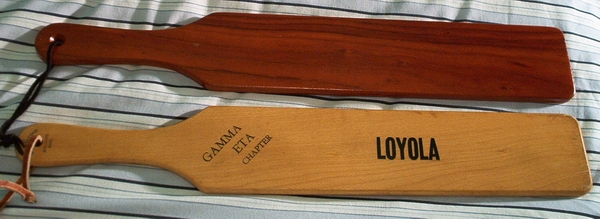
Illustration 2.4 Assume the position! A classic, but use carefully because of the length and weight. Bottom: Genuine fraternity/sorority model crafted by L.G. Balfour sometime in the 60’s. Top: Exotic version of the standard fraternity paddle made of African Padauk (Pterocarpus soyaxii) by Hanson Paddle Werks. We call this the “standard” paddle because so many were made with these dimensions (22” long, 3 ½” wide, ½” thick). The hole in the handle of the Hanson version has been beveled – not necessary for hanging, but if you want holes in the business end, they should look like this. Author’s collection. |
Fraternity/Sorority Paddles (see Illustration 2.4) - Probably the first type that comes to mind when the average person thinks of paddles. Our semi-arbitrary "standard" size for these is 22" long by 3 ½" wide by ½" thick, which in fact were the measurements used for many of these. Most school paddles are similar. They occupy a prominent place in spanking fantasies and certainly can be used, but they have two drawbacks. The extreme length gives tremendous leverage but can easily lead to azimuth misalignment (see my how to article), and in combination with the weight means they must be used carefully. |
||
|
Actual fraternity "technique" which consists of using the paddle full force (sometimes with a two-handed grip) should be avoided (remember that only one or two swats are usually given, which of course tempts the Top to overdo it, and even then the boys are all bruised - and sorority girls are no better). I prefer to use a one-handed grip and to give lighter, more numerous swats (again, see the article). Most male Tops can easily handle the weight of a fraternity paddle one-handed, but I have heard some female Tops complain they are too difficult (because the length and weight demand more strength in the wrist and forearm than other styles). For female Tops, if a heavy paddle is desired, a Platform Tennis type (see below) might be a better choice. Now, I'm not trying to discourage anyone from using these paddles - at the very least, those who have always fantasized about them should certainly give them a try - but they must be used with intelligent restraint, something drunken frat boys and ignorant school administrators are not known for. Some people may well end up preferring them. Once I was instructing a nice young couple in proper paddling technique (not my day job, alas - this was at a spanking party). I gave the girl several swats with a lighter paddle to show the boy how, and when he had tried out a couple of paddles himself he said he favored the fraternity style. |
|||
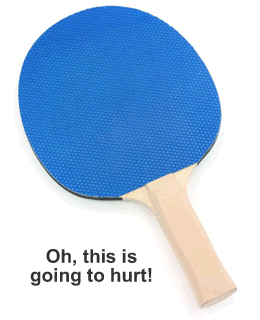
Illustration 2.5 |
Ping-Pong Paddles (Illustration 2.5) - as I have stated, I generally favor lighter paddles, but these are too thin - they give almost no sting at all. The shape is actually o.k. for spanking, but the handle is too short. I suppose you could make your own more-substantial version by tracing an outline on a flat piece of 5/16" pine, oak, etc., and lengthening the handle somewhat, but it doesn't seem worth the effort to me. The only time I've actually seen a ping-pong paddle used for spanking was in a video from the Blind Date T.V. series. It shows a girl bending over a ping-pong table getting swats with one after losing a match! You can see that the girl is one of us - a true spankophile - and you can't help feeling sorry for her as you witness her obvious embarrassment at having her secret spanking desires accidentally exposed on nation-wide T.V. She seemed very sweet and sincere, too - a prize catch actually - so I hope her date appreciated his good fortune, and wherever she is now, I hope she's doing o.k. And I promise to stop embarrassing her further by continuing to remind everyone how much she likes getting spanked. Yes, I'm going to stop embarrassing her any time now ... |
||
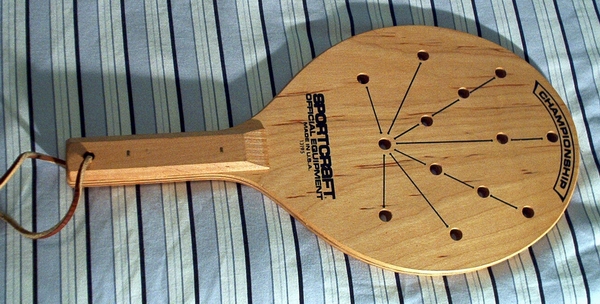
Illustration 2.6 Platform Tennis Paddle, ½” plywood, by Sportcraft. Not intended for spanking purposes, yet it works very well because of the comfortable handle and shorter length (than the fraternity paddle) of 15”. If you want to go up to ½” thickness, this would be my first choice. The holes, apparently intended for ball control, are not beveled, but are just small enough that they don’t cause any problems. I actually witnessed a student paddled with one by a coach in 1973. Author’s collection, manufactured c. 1978. |
Platform Tennis Paddles (see Illustration 2.6) - the big brother of the Ping-Pong paddle, these demand to be taken more seriously! They are made of ½" hard plywood for strength, are about the size of tennis racquets, have holes in them already (for ball control), and are actually used on students by some school coaches although they were not originally intended for spanking purposes. Because they have good racquet-style handles and are shorter than standard frat paddles, they are easier to control and may be the best of the "heavy" class of paddles (i.e. the ½" thick ones). They may be hard to find because Platform Tennis isn't a very common sport (it is similar to racquetball but is played on an open court). A quick search did turn up Viking Athletics , which features paddles with quite innocently-chosen yet amazing names such as "Attitude" (this will adjust it) and "Ignite" (it will surely set fire to the fanny!). Interestingly, the company's motto is "Paddle is Our Passion". Ours too. |
||
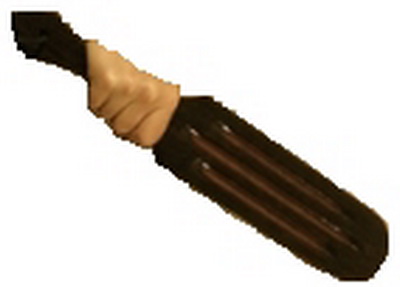
Illustration 2.7 |
Finger Paddles (see Illustration 2.7) - This does not refer to a hand-shaped paddle, but to a rectangular one with thin strips of rubber or metal running lengthwise. My old teacher didn't have one of these, but there was one at a nearby Catholic school. They must always have been rare, and I could not even find a picture of one for this article at the time I wrote it in 2008. Later I found the low-resolution photo you see at left. The idea apparently was to enhance the sting, and it's interesting to contemplate how many people over the years seem to have believed that a solid wooden paddle just wasn't stingy enough on its own. |
||
|
Additional Types and Features of Leather Paddles: |
|||
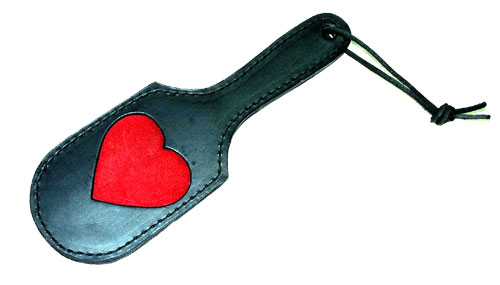
Illustration 3.1 Insert Paddle – gives new meaning to the expression “feel the love”! |
Insert (see Illustration 3.1) – these have cut-out shapes whose purpose is to leave an imprint. Unlike the triangle paddle (see above), these would probably work. I’ve never tried them, though, because I prefer to administer a large number of swats and I’m not sure how many you could give with one of these. One possibility would be to use another implement first for the main part of the paddling, and then give one last good whack with an insert paddle, to “make your mark”. Try a heart-shaped insert to show her you care. |
||

Illustration 3.2 |
Large Leather Paddle (see Illustration 3.2) - These are patterned after wood models and are generally somewhat thicker than the typical oval-shaped leather ones. They pack a surprising wallop, and I have found them to be excellent for "maintenance" type paddlings. |
||
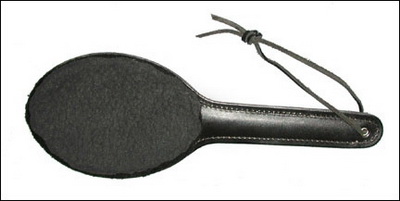
Illustration 3.3 |
Soft-Lined (from JT’s Stockroom, see Illustration 3.3) – good for sensual use. The other side is plain, so you can alternate gentle swats with stingier ones. |
||
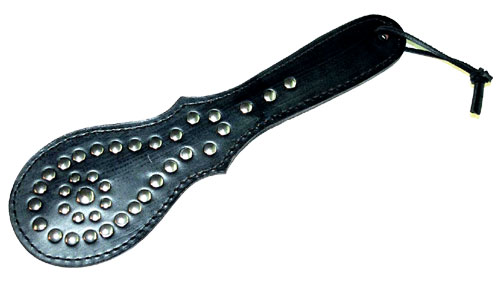
Illustration 3.4 |
Studded (Illustration 3.4) – a very good choice if you want your girlfriend to break up with you. |
||
|
Appendix – On Kinetic Energy and Momentum As They Apply to Paddling |
||
|
We need only two definitions: KE = ½MV2 where KE = kinetic energy, M = mass, and V = velocity Momentum = MV, where M = mass and V = velocity Suppose we have two paddles P1 and P2, of masses M1 and M2, where M1 < M2 (in other words, P1 is lighter than P2). Let us imagine we apply P1 with greater speed to make up for its lesser weight, in such a way that the extra speed is just enough to give us the same momentum we had with the heavier paddle P2. Since the momenta are equal, we have M1V1 = M2V2, where of course V1 > V2. Solving for one variable in terms of the other three, we have M1 = M2V2/V1. Let us compare the KE possessed by the two paddles. For P1, KE = ½ M1V12, and for P2, KE = ½M2V22. Taking the ratios for comparison purposes, we have
½M1V12 = (M2V2/V1)(V12) = V1 Therefore we conclude that the lighter paddle has the greater KE (since V1 > V2), and in proportion to how much faster it is applied than the heavier one. To take a simple example, if M2 = 2M1, then V2 = ½V1 (remember we are choosing the velocities in such a way that the momenta are equal), and the lighter paddle will have twice the KE. Of course, if we were to apply P1 and P2 at the same speed, P2 would have twice as much of both KE and momentum (ouch!). This is why we intuitively take it easier with heavier paddles. Another way to examine this question is to consider how Momentum and KE vary as the speed of the paddle, disregarding mass. This is reasonable since we can’t change the mass of any particular paddle, only the speed at which it is applied. Consider the functions F(v) and G(v), defined by F(v) = mv and G(v) = ½mv2, where the mass m may be treated as a constant. Since v2 increases faster than v, it is reasonable to infer that for large enough values of v, KE will increase more rapidly than momentum. We can prove this with a little elementary calculus. Differentiation of F and G gives F’(v) = m and G’(v) = mv = F(v). (F’ and G’ may be thought of as the instantaneous rate of change in Momentum and KE with respect to v). Since m > 0 and v > 0, for values of v > 1, G’(v) > F’(v), hence KE is increasing faster than momentum. It would be well to remember that the point of the foregoing discussion with respect to practical paddling considerations is that lighter paddles at greater speed will have more KE in comparison to momentum (more sting); while heavier paddles at lower speed will have less KE in comparison to momentum (more thud). |
|
|
Back to ARTICLES page |
|
|
Back to HOME page |